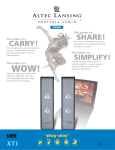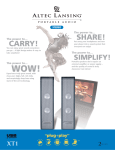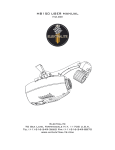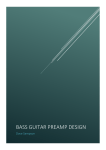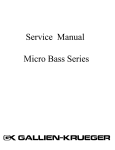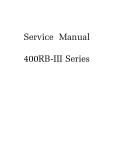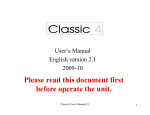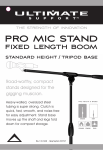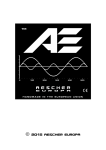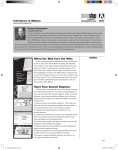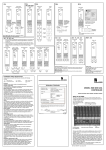Download PerformingMusician
Transcript
Gallien-Krueger MB150E Combo bass amp Phil Ward I t’s only when you see a Gallien-Krueger MB150E in the flesh that you appreciate just how small it is. I’d seen pictures in magazines and on web sites and I knew it was small, but sitting next to me now it really is tiny for a bass combo of genuine gigging aspirations. ‘Tiny’ is not a word very often associated with anything to do with reproducing bass. The very nature of low-frequency sound means that to generate any significant acoustic energy, the signal amplitude has to be high. In practical terms, that means to reproduce bass you need to physically shift a lot of air. That’s why double basses, low-register organ pipes, subwoofers and serious PA or hi-fi speakers are big — it’s all about bullying big slugs of air backwards and forwards. So what does Gallien-Krueger know that the rest of us don’t? How can a bass combo that’s literally less than knee-high to a bass player do the business? Is it just slick marketing, a case of king’s new clothes, or clever engineering? Now, without wishing to give the game away before the first paragraph is done (although if you’re like me, you probably read the conclusion paragraph first anyway), it’s not black magic or slick marketing — it’s clever engineering. Versatility Before I go on to describe why I’ve dropped the MB150E into the ‘clever engineering’ category, some background and description would probably not go amiss. First, it’s tiny — have I already mentioned that? Second, the PerformingMusician MB150E Combo £753 Clever engineering, a high maximum volume level and a wide range of preamp sound-shaping facilities make this combo a versatile solution for gigs in small to medium venues. And it’s also incredibly portable! Beyerdynamic +44 (0)1444 258258 www.beyerdynamic.co.uk www.gallien-krueger.com 128 June 2008 | performing-musician.com Gallien-Krueger continue to provide high-quality compact bass amplification for the gigging musician with their MicroBass Series III amps, offering a sound that belies their diminutive appearance. MB150E is a 100W combo with a single 12-inch driver. Third, for those that need more volume, Gallien-Krueger manufacture a matching extension speaker cabinet that halves the impedance seen by the amplifier, and brings the output power up to 150W. And fourth, while the MB150E is the size of a beginner’s practise combo, it’s priced significantly above practise combo territory and is intended for serious gigging applications. The gig applications are of a particular kind, however, because despite the cleverness inherent in the way the MB150E is engineered, it cannot defy the laws of physics completely. Turn up to a stadium gig with a full band and a loud drummer, and you’ll undoubtedly find the MB150E out of its depth. Turn up to a more intimate gig with a band that values hearing over loudness, however, and the MB150E will be in its element. It’s no surprise that some familiar jazz double bass names endorse the MB150E — Charlie Haden, Ron Carter and Dave Holland, to name three. The MB150E is a versatile combo, however, and despite those double bass endorsements, it is just as capable of performing with a conventional electric bass or, as in my particular case, various instruments ranging from a fretless Wal Custom to a Steinberger electric upright. The versatility comes not only from the MB150E’s inherent neutral balance, clean tone and surprisingly high maximum volume level, but also from the comprehensive range of tonal and dynamic sound-shaping facilities offered by its preamp section. Take a deep breath. The preamp controls, from left to right, go like this… Preamp controls First up is an input jack socket and a -14dB pad switch to attenuate any particularly high-output instruments. Both the Wal and the Steinberger fall into that category, and I suspect the majority of recent active instruments would also. Preamp Volume is next, followed by the first of the MB150E’s tone-shaping controls. This takes the form of a Low Cut switch that attenuates by quite a significant 17.5dB at 40Hz. Taking a chunk out of the low-frequency response is not only useful in those gig environments where you find yourself stuck in the corner at the back of the flimsy, resonant platform that passes for a stage, but it can also increase the maximum effective volume level available (effectively trading bass extension for volume). The Bass Cut switch is followed by two rotary controls — Contour and Hi-Boost (actually called ‘Presence’ in the MB150E user manual). Hi-Boost is self-explanatory; it adds level around 2kHz to give some added, well, presence. The Contour control boosts at both high and low frequencies, while simultaneously cutting at around 500Hz. The contour concept is one that seems to have gained general acceptance among bass players as a quick route to achieving the right tonal character to suit a particular musical and playing style. It’s one I quite like too, and I find setting the basic tone using the controls on the instrument itself and then using a contour control to fine-tune the sound to suit the gig works well. My only criticisms of the MB150E’s Contour control are that its 500Hz centre frequency seems a little high (I’d have preferred something around 350Hz), and that the control knob itself is too small for these gnarled, fat and lumpy bass player’s fingers. That criticism goes for all the small controls on the MB150E front panel. The MB150E is definitely not short of tonal adjustment facilities, though, because along from the Contour control is a set of conventional tone controls comprising bass, treble and two parametric mid-range sections. These all have sensibly sized control knobs. But, to my eyes, with treble on the left and bass on the right, they’re ordered the wrong way. I kept reaching for the wrong end. And still we’re not finished with the MB150E’s controls. Next up is a Boost control. Use Boost carefully and it can add a pretty reasonable valve-like warmth and dirt to the sound. Use it carelessly and it can sound somewhat unfortunate. Moving swiftly on then, next up are Chorus in/out, Rate and Depth controls. Yes, you read that correctly, a bass combo with onboard stereo chorus (with stereo line-out jacks on the rear panel). Now, I started playing bass in the late ‘70s and, thanks to the inexorable lure of ‘80s pop, have a soft spot for chorus on bass (reverb too, actually, but I’m having counselling and hope to give up soon). However, I didn’t really get along that well with the MB150E’s chorus and I doubt I’d use it more than very occasionally. Like the Boost control, it seemed too severe, and with anything more than a little depth and slow rate, the sound quickly degenerated, to my ears, towards the unusable. Even set to near minimum rate and depth, it seemed to bring a hard edge to the sound of the combo, which meant I had to adjust the EQ and I’m not sure my soft spot for chorus extends quite that far. You may love it, however, and you won’t find many other bass combos with onboard chorus. Chorus is followed by the Output volume control and, finally, the Limiter in/out switch and Level section, which behaves exactly as expected and progressively limits the combo’s maximum output — effectively a single-knob compressor. It works pretty well too. A headphone socket completes the preamplifier’s front panel facilities. Moving around to the rear panel, the combo misses little in the way of connectivity. In no particular order, the MB150E incorporates an extension cabinet output, an internal speaker on/off switch, effects send and return jacks, a Chorus and Boost footswitch jack, stereo line out jacks and a ground lift switch. “Clever engineering” You’ll remember that I promised to explain why I dropped the MB150E into the ‘clever engineering’ category. Well, the cleverness Tech Spec MB150E Combo • 100W output power. • XLR line level and quarter-inch loudspeaker connectors. • 12-inch low-resonance Paragon woofer. • Active four-band EQ. • Adjustable contour, high boost and low cut. • Boost (valve effect). • Stereo chorus (foot switchable). • Limiter. • Send, return, line out and headphone out. • Dimensions (WDH): 13.5 x 8.5 x 16 inches. • Weight: 26lbs. begins with the way the combo is constructed. Plywood, chipboard and MDF have long been the materials of choice for speaker cabinets, be they hi-fi speakers or backline combos. These wooden material options are adequately strong, easy to work, inexpensive and easy to finish with veneers, paint or fabric, but they are both thick and heavy (thanks to the 15mm or more panel thickness needed for that adequate strength). The MB150E is, however, not constructed from heavy wooden panels, but from 3mm-thick aluminium sheet. Not only are thin aluminium panels significantly lighter than those made from ‘wood’, but they eat into the cabinet’s internal volume far less. For example, the MB150E’s internal volume — the air volume that encloses the driver — is approximately 24 litres. If it were constructed from 15mm MDF panels (and were the same external size), its internal volume would be around 18 litres. So construction from aluminium panels effectively wins 33% more internal volume for the driver. More internal volume means the driver’s low-frequency resonance falls and it can reproduce bass more effectively. The cleverness of the MB150E also extends to its driver and the way it is loaded in the cabinet. In comparison with bass combos featuring much larger and/or multiple drivers, the MB120 single 12-inch unit might seem underwhelming. However, it’s not just driver surface area that counts, but the volume of air that drivers can shift — surface area multiplied by the distance the cone can move. The MB150E driver, as witnessed by its very generous roll surround, is a large displacement unit that can move a long way (and shift a lot of air). The MB150E is also a sealed box combo, rather than being reflex loaded, meaning that its low-frequency roll-off will be relatively gentle. There’s significant evidence too that sealed box speakers generally produce clearer, tighter and more accurate bass. In use So the MB150E is clever, but how does it sound? Well, given the limitations I described right back at the beginning (ie. no rock band stadium gigs), the MB150E will probably sound just the way you want it to. It may take a while to find the right sounds thanks to the complexity of the preamplifier (in which case, the less sophisticated and slightly less expensive MB150S might be more appropriate), and you may also be frustrated by the small control knobs and the not particularly clear legends on the front panel (I wouldn’t want to be messing with the controls on a dark stage between songs). However, if you’re a bassist like me, who plays a mix of small to medium venues with a variety of instruments in not particularly loud bands, and who values extreme portability, the MB150E is very classy, pretty much unique and has to be near the top of the ‘interesting’ list. performing-musician.com | June 2008 129


